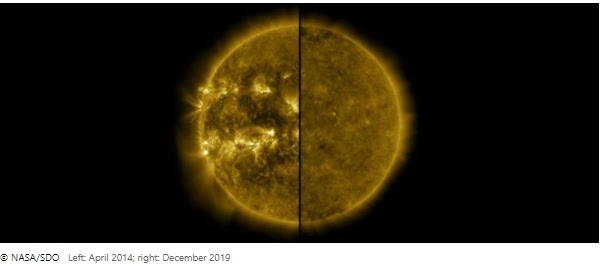Away from the worries of the planet, our sun is having a quiet year. A closer look at its activity confirms that solar enthusiasts have been skeptical for some time - our closest star has entered a new cycle.
Ever since we began
seriously tracking the sun's dark spots, humans have seen a pattern of silence
and mood that repeats itself every 11 years.
Since the first
observations were recorded’ in the mid-18th century, 24 of them have taken
place. And, according to a panel of experts from NASA and the National Oceanic
and Atmospheric Administration (NOAA), the number 25 started in December 2019.
You can't be blamed’
for not watching the shift. There was no light, no cosmic trumpets. Just an
appearance of a low temperature shadow called the sunspot at high latitudes.
"We have a
detailed record of the small spores that mark the beginning and the beginning
of a new cycle," says Frederick Cleat, director of the World Data Center
Sunspot Index and Long-Term Solar Observations.
"These are the low
heralds of the future giant solar fireworks. Only by detecting the general
trend in several months can we determine the tipping point between the two
cycles."
In practice, changes in
the Sun's behavior make it impossible to identify a new beginning until it has
passed. Last year's confirmation of stabilizing solar activity data over the
last eight months was as boring as the sun's approach for the next decade.
Despite centuries of
careful recording of these 11-year cycles, we still do not have a mechanism to
fully work behind these cycles. It is common in stars from time to time. When
you explore the universe, there are a lot of plastics that seem to flare up and
darken from time to time so that you can almost make your watch.
The best we can
determine for our own solar patterns has to do with changes in magnetic fields,
driven by complex currents flowing within the depths of the plasma within it.
In fact, it is the part
we need to estimate that pushes and pulls these currents in such a fluctuating
way, but there is a temptation that connects it to the planets in a similar
interval.
"When we exit the
solar minimum and complete the maximum of cycle 25, it is important to remember
that solar activity never stops. It changes as the pendulum changes,"
wrote NASA's solar scientist Lika Guhathakurta says.
Although the cycle of
heights and arches lasts for more than 11 years, it is more accurately a
reflection of the larger 22-year cycle, which is explained’ by the complete
reversal of the Sun's polarity. The poles change every 11 years, returning to
place at the end of the next loop.
Monitoring these
transitions can help us better predict space weather, which applies to
large-scale charged plasma and radiation that can be dispersed into space,
especially from solar energy.
It will be about five
years before we can say that we are in the more aggressive phase of the sun.
That doesn't mean we don't have to pay attention anymore.
It remains to be seen’
whether the Solar Cycle 25 will be on display, although it is unlikely to
explode. No. 24 was relatively quiet, but mostly stronger than usual in
previous cycles.
"Just because it's
less than the average solar cycle," says Doug Biesecker, co-chair of the
panel at NOAA's Space Weather Forecast Center in Colorado and a solar
physicist.
"The effect of the
sun on our daily lives is real and still is."
It also pays to be
realistic about what the effect is, especially if you don't have a spacesuit
with a space engineer managing high-speed protons and X-rays or a group of
fragile satellites.
Here on the surface,
adapted to kilometers of atmosphere, solar cycles are barely noticeable. If
you're lucky, you may find the aurora activity lighter during the solar
maximum. Most of the time we don't have to worry as much about destroying the
life of solar flares as we know.
One thing is for sure:
any connection between disappointing events and the swampy mood of the sun,
rather than 2020, is the best metaphor. Still, no one can help but sometimes
wonder what the stars are thinking.
READ MORE







